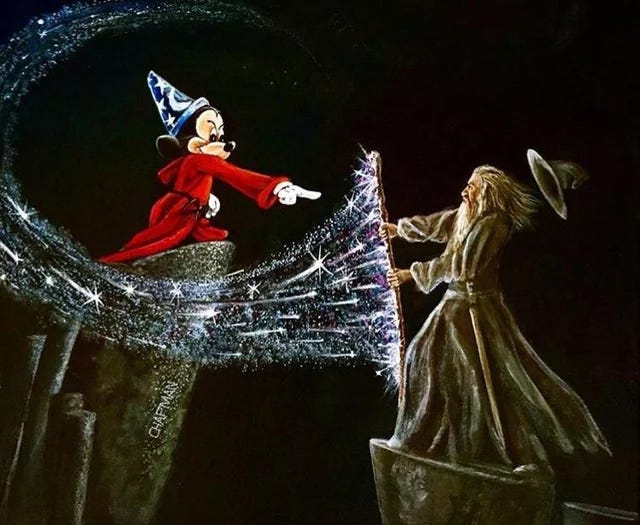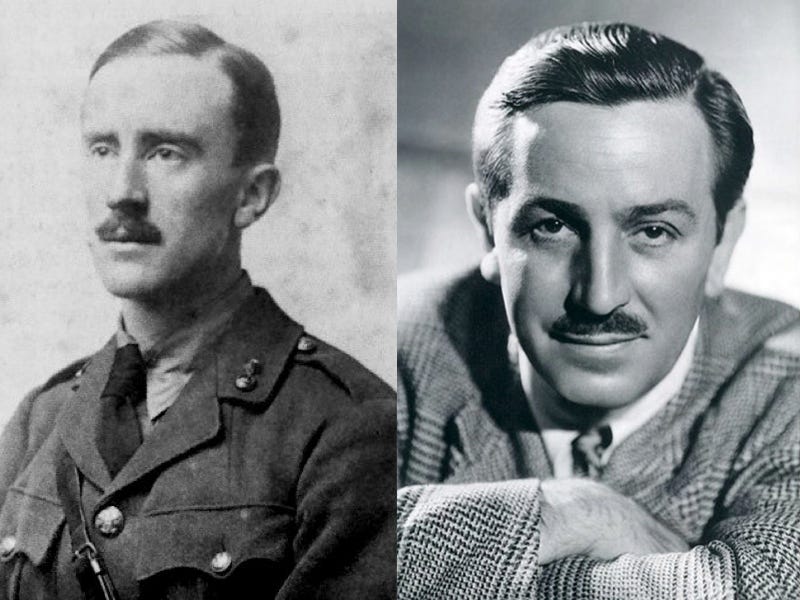Tolkien vs. Disney: Who Got It Right?
Disney reminds you to delight. Tolkien reminds you to bleed.
The year was 1937, and two works of fantasy, two radically different visions of fantasy, appeared just months apart.
The first opened, quite literally, in a hole in the ground, where there lived a hobbit. It was a children’s book from Oxford professor J.R.R. Tolkien, who had spent decades steeped in the myths, languages, and legends of Europe.
The second was a full-length animated film from a rising creative force named Walt Disney. It told the story of a singing young woman and her seven dwarven friends, and became the first commercially successful feature-length animated film in history: Snow White and the Seven Dwarfs.
Not long after Snow White debuted, Tolkien went to see it with his friend C.S. Lewis. (This is now one of my favorite mental images: two tweed-clad literary giants sitting in a darkened theater, watching a cartoon princess sing to woodland animals.)
But Tolkien was not charmed.
In a private letter that later became not-so-private, he called Disney Studios “hopelessly corrupted” and vowed never to let Disney’s hands anywhere near his hobbits or any of his other creations.
This was not just grumpiness or artistic snobbery. It was a symptom of a much deeper philosophical divide between Tolkien and Disney, a divide that still shapes how we tell stories today.
Today, we are dipping our toes into that tension to explore one question: Why did Tolkien hate Disney?
To understand Tolkien’s disgust with Disney, you have to see what fueled his own imagination.
Tolkien spent much of his career buried in ancient languages and early medieval texts. When you live that deep in Old English, Norse, and Finnish epics, you eventually start inventing languages of your own.
He was fantastical, yes, but not in a shallow, glitter-and-magic-wands sort of way. Tolkien believed that the old fairy tales preserved truths the modern world was too quick to discard.
For him, the magic of these stories had little to do with talking dragons or sweeping landscapes. The power was in how they wrestled with eternal realities like evil, suffering, sacrifice, and the nature of true heroism.
Myths, in Tolkien’s mind, were not a form of escapism. They were a compass for navigating the struggles of real life.
He believed all humans were “sub-creators,” made in the image of the Creator and designed to create in turn. And create he did—entire worlds populated with beauty and peril, crafted to show the evils that lie in the hero’s path.
While The Lord of the Rings ends in triumph, the victory is only earned through relentless suffering, loss, and sacrifice. Which helps explain why Tolkien reacted so sharply to Disney’s work. He did not see life as a string of cheerful songs leading to a happy ending. He saw the road to joy as passing first through the valley of death—a narrative arc Tolkien called ‘eucatastrophe,’ where joy crashes in only after real loss.
So, was Disney full of sugar, or was Tolkien full of disdain?
While Tolkien’s worlds were marked by darkness, evil, and hard-won triumph over death, he believed Disney had sanded away the jagged edges until only sweetness remained.
This likely came from what Tolkien knew of the Brothers Grimm’s 1812 version of Snow White. In that version, the young girl is hunted repeatedly by a murderous stepmother, bargains for protection with the dwarves, and watches as the evil queen is punished by being forced to dance to death in red-hot iron shoes.
A far cry from Disney’s adaptation.
** To be fair, early Disney wasn’t pure sugar. Snow White still has the terror of the forest. Pinocchio turns boys into donkeys. Bambi loses his mother. But compared to the Brothers Grimm, the darkness is curated, softened, and packaged for family audiences.
In terms of tone and substance, Disney was as different from Grimm as a roller coaster is from a rocking chair.
The dark edges of Snow White were replaced with singing birds, wide-eyed woodland creatures, and romance sealed with a kiss. Snow White is welcomed without suspicion, evil is defeated with minimal effort, and everyone lives happily ever after.
Tolkien believed that stripping a story of its darker elements severed it from its purpose. Without darkness, there could be no light, and without real trial, there could be no transformation.
In the Disneified world, suffering was optional. Redemption required no cost. Evil left no lasting scar.
So, should we write and wrestle with suffering, or keep our eyes locked forward to better days and times?
In many ways, Tolkien and Disney lived at opposite ends of the storytelling spectrum.
Disney looked to the future. He embraced new technology with open arms and filled his projects with visions of the world as it could be.
Tolkien romanticized the past. He warned against the creeping dangers of industrialization and poured his love of ancient and medieval history into every page.
It is no surprise that Tolkien harbored such resentment toward Disney’s approach. And yet, his critiques did nothing to slow Disney’s meteoric rise. Today, Snow White and The Lord of the Rings stand side by side as cultural landmarks, both shaping generations of imaginations.
🧪 Practical guardrails for your story
Face the dark
Disney’s forest was scary, but Tolkien would have let you feel the hunter’s dagger on your neck. Do the same. Make the danger real enough to leave a scar. If your villain never wins, your hero’s win feels weightless. Let evil have teeth, trust shatter, and heroes betray.
Offer real redemption
In The Return of the King, triumph costs Frodo a finger, peace in the Shire, and his friendships. Do the same. Let victories wound, friendships strain, and homecomings ache. If nothing is lost, nothing is truly won.
Honor memory and imagination
Tolkien rooted his worlds in ancient myths. Disney built his in imagined futures. Great storytellers do both. Preserve the truths that anchor us while painting the worlds that could be. Let your work hold the past in one hand and possibility in the other.
Earned-joy audit
Remove the last scene of celebration. Does the story still resolve meaningfully? If not, you leaned on confetti rather than change. Joy should feel like the natural outflow of endured struggle, not a quick fix for the sake of applause.
Price of grace ledger
List your story’s final victory. Then list what it cost each character. If anyone escapes untouched, ask why. Raise the price until the reader feels the weight of the win and believes it was worth what your characters paid.
👉 In the end, both are gifts, but incomplete on their own.
The sweet spot for Christian storytellers is honest enchantment: let darkness bite, let light sing, and make grace expensive.
Disney reminds you to delight. Tolkien reminds you to bleed. Do both, at proportions that match your audience and purpose.
MY BEST FINDS
I scoured the internet, and here are the best things I could find this week. If you find something worth sharing with the rest of the Lab, reply to this email!
🧙♂️ Story
The five-step process for authentic writing that nobody teaches you (How I Write)
5 genius tricks for writing witty banter and funny dialogue, even if you’re as dry as a Saltine cracker (YouTube)
A step-by-step guide breaking down exactly how to build & launch a high-converting newsletter landing page in 90 minutes (Funnel Breakdowns)
How to write useful stuff even if you’re a bad writer —> written in 12 rules (Newsletter Operator)
💡 Marketing
This Times Square ad looks like it was written in a drunk text thread, and it was brilliant (LinkedIn)
Frida made breast milk-flavored ice cream. It’s a bad idea, but they are riding the publicity nonetheless (ABC News)
👀 ICYMI
What 5 insane ads taught me about great marketing (Christian Story Lab)
My most popular post featured Mickey vs. Gandalf in a magic brawl (LinkedIn)
AOL is finally shutting down dial-up (The Verge)
~
Keep writing what matters,
— Payton
P.S. If there a fellow writer, copywriter, marketer in your orbit who would benefit from these emails, here is a fancy button to click 👇





Loved theses examples so much. Thank you for sharing.